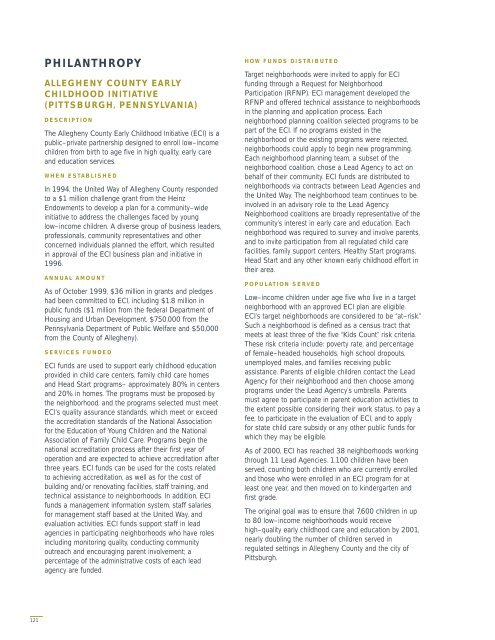Financing Child Care in the United States - Ewing Marion Kauffman ...
Financing Child Care in the United States - Ewing Marion Kauffman ...
Financing Child Care in the United States - Ewing Marion Kauffman ...
Create successful ePaper yourself
Turn your PDF publications into a flip-book with our unique Google optimized e-Paper software.
PHILANTHROPY<br />
ALLEGHENY COUNTY EARLY<br />
CHILDHOOD INITIATIVE<br />
(PITTSBURGH, PENNSYLVANIA)<br />
DESCRIPTION<br />
The Allegheny County Early <strong>Child</strong>hood Initiative (ECI) is a<br />
public–private partnership designed to enroll low–<strong>in</strong>come<br />
children from birth to age five <strong>in</strong> high quality, early care<br />
and education services.<br />
WHEN ESTABLISHED<br />
In 1994, <strong>the</strong> <strong>United</strong> Way of Allegheny County responded<br />
to a $1 million challenge grant from <strong>the</strong> He<strong>in</strong>z<br />
Endowments to develop a plan for a community–wide<br />
<strong>in</strong>itiative to address <strong>the</strong> challenges faced by young<br />
low–<strong>in</strong>come children. A diverse group of bus<strong>in</strong>ess leaders,<br />
professionals, community representatives and o<strong>the</strong>r<br />
concerned <strong>in</strong>dividuals planned <strong>the</strong> effort, which resulted<br />
<strong>in</strong> approval of <strong>the</strong> ECI bus<strong>in</strong>ess plan and <strong>in</strong>itiative <strong>in</strong><br />
1996.<br />
ANNUAL AMOUNT<br />
As of October 1999, $36 million <strong>in</strong> grants and pledges<br />
had been committed to ECI, <strong>in</strong>clud<strong>in</strong>g $1.8 million <strong>in</strong><br />
public funds ($1 million from <strong>the</strong> federal Department of<br />
Hous<strong>in</strong>g and Urban Development, $750,000 from <strong>the</strong><br />
Pennsylvania Department of Public Welfare and $50,000<br />
from <strong>the</strong> County of Allegheny).<br />
SERVICES FUNDED<br />
ECI funds are used to support early childhood education<br />
provided <strong>in</strong> child care centers, family child care homes<br />
and Head Start programs– approximately 80% <strong>in</strong> centers<br />
and 20% <strong>in</strong> homes. The programs must be proposed by<br />
<strong>the</strong> neighborhood, and <strong>the</strong> programs selected must meet<br />
ECI’s quality assurance standards, which meet or exceed<br />
<strong>the</strong> accreditation standards of <strong>the</strong> National Association<br />
for <strong>the</strong> Education of Young <strong>Child</strong>ren and <strong>the</strong> National<br />
Association of Family <strong>Child</strong> <strong>Care</strong>. Programs beg<strong>in</strong> <strong>the</strong><br />
national accreditation process after <strong>the</strong>ir first year of<br />
operation and are expected to achieve accreditation after<br />
three years. ECI funds can be used for <strong>the</strong> costs related<br />
to achiev<strong>in</strong>g accreditation, as well as for <strong>the</strong> cost of<br />
build<strong>in</strong>g and/or renovat<strong>in</strong>g facilities, staff tra<strong>in</strong><strong>in</strong>g, and<br />
technical assistance to neighborhoods. In addition, ECI<br />
funds a management <strong>in</strong>formation system, staff salaries<br />
for management staff based at <strong>the</strong> <strong>United</strong> Way, and<br />
evaluation activities. ECI funds support staff <strong>in</strong> lead<br />
agencies <strong>in</strong> participat<strong>in</strong>g neighborhoods who have roles<br />
<strong>in</strong>clud<strong>in</strong>g monitor<strong>in</strong>g quality, conduct<strong>in</strong>g community<br />
outreach and encourag<strong>in</strong>g parent <strong>in</strong>volvement; a<br />
percentage of <strong>the</strong> adm<strong>in</strong>istrative costs of each lead<br />
agency are funded.<br />
HOW FUNDS DISTRIBUTED<br />
Target neighborhoods were <strong>in</strong>vited to apply for ECI<br />
fund<strong>in</strong>g through a Request for Neighborhood<br />
Participation (RFNP). ECI management developed <strong>the</strong><br />
RFNP and offered technical assistance to neighborhoods<br />
<strong>in</strong> <strong>the</strong> plann<strong>in</strong>g and application process. Each<br />
neighborhood plann<strong>in</strong>g coalition selected programs to be<br />
part of <strong>the</strong> ECI. If no programs existed <strong>in</strong> <strong>the</strong><br />
neighborhood or <strong>the</strong> exist<strong>in</strong>g programs were rejected,<br />
neighborhoods could apply to beg<strong>in</strong> new programm<strong>in</strong>g.<br />
Each neighborhood plann<strong>in</strong>g team, a subset of <strong>the</strong><br />
neighborhood coalition, chose a Lead Agency to act on<br />
behalf of <strong>the</strong>ir community. ECI funds are distributed to<br />
neighborhoods via contracts between Lead Agencies and<br />
<strong>the</strong> <strong>United</strong> Way. The neighborhood team cont<strong>in</strong>ues to be<br />
<strong>in</strong>volved <strong>in</strong> an advisory role to <strong>the</strong> Lead Agency.<br />
Neighborhood coalitions are broadly representative of <strong>the</strong><br />
community’s <strong>in</strong>terest <strong>in</strong> early care and education. Each<br />
neighborhood was required to survey and <strong>in</strong>volve parents,<br />
and to <strong>in</strong>vite participation from all regulated child care<br />
facilities, family support centers, Healthy Start programs,<br />
Head Start and any o<strong>the</strong>r known early childhood effort <strong>in</strong><br />
<strong>the</strong>ir area.<br />
POPULATION SERVED<br />
Low–<strong>in</strong>come children under age five who live <strong>in</strong> a target<br />
neighborhood with an approved ECI plan are eligible.<br />
ECI’s target neighborhoods are considered to be “at–risk.”<br />
Such a neighborhood is def<strong>in</strong>ed as a census tract that<br />
meets at least three of <strong>the</strong> five “Kids Count” risk criteria.<br />
These risk criteria <strong>in</strong>clude: poverty rate, and percentage<br />
of female–headed households, high school dropouts,<br />
unemployed males, and families receiv<strong>in</strong>g public<br />
assistance. Parents of eligible children contact <strong>the</strong> Lead<br />
Agency for <strong>the</strong>ir neighborhood and <strong>the</strong>n choose among<br />
programs under <strong>the</strong> Lead Agency’s umbrella. Parents<br />
must agree to participate <strong>in</strong> parent education activities to<br />
<strong>the</strong> extent possible consider<strong>in</strong>g <strong>the</strong>ir work status, to pay a<br />
fee, to participate <strong>in</strong> <strong>the</strong> evaluation of ECI, and to apply<br />
for state child care subsidy or any o<strong>the</strong>r public funds for<br />
which <strong>the</strong>y may be eligible.<br />
As of 2000, ECI has reached 38 neighborhoods work<strong>in</strong>g<br />
through 11 Lead Agencies. 1,100 children have been<br />
served, count<strong>in</strong>g both children who are currently enrolled<br />
and those who were enrolled <strong>in</strong> an ECI program for at<br />
least one year, and <strong>the</strong>n moved on to k<strong>in</strong>dergarten and<br />
first grade.<br />
The orig<strong>in</strong>al goal was to ensure that 7,600 children <strong>in</strong> up<br />
to 80 low–<strong>in</strong>come neighborhoods would receive<br />
high–quality early childhood care and education by 2001,<br />
nearly doubl<strong>in</strong>g <strong>the</strong> number of children served <strong>in</strong><br />
regulated sett<strong>in</strong>gs <strong>in</strong> Allegheny County and <strong>the</strong> city of<br />
Pittsburgh.<br />
121
















